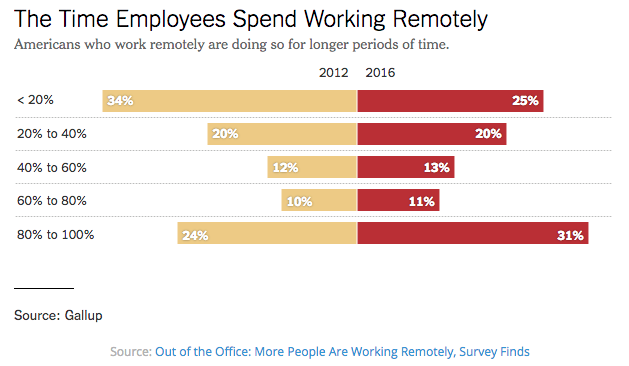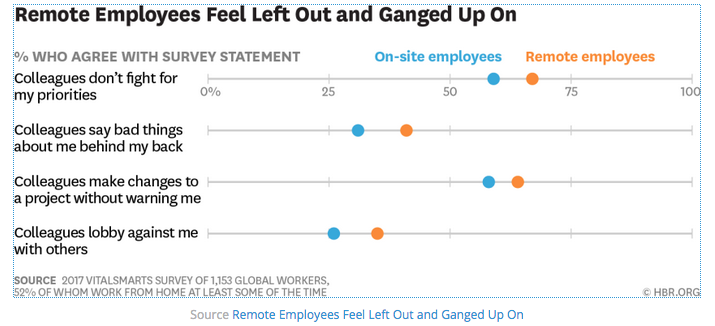Three Strategies to Grow a Happy, Productive Remote Team
 Creating a remote culture where employees can thrive is an increasingly critical challenge for companies. Hiring the right people to work remotely is just the start. Building a successful remote culture requires you to invest in a strategy and processes where remote workers can perform at their best. If you don’t, it can be a recipe for disaster.
Creating a remote culture where employees can thrive is an increasingly critical challenge for companies. Hiring the right people to work remotely is just the start. Building a successful remote culture requires you to invest in a strategy and processes where remote workers can perform at their best. If you don’t, it can be a recipe for disaster.
For some of you, building a remote team is a necessity. You need to find the right talent at the right budget for your business. For others, it is something that your employees are asking for so that they can have a more flexible schedule, spend more time with family or avoid long commutes. Either way, it is a workplace trend that is growing. Forty-three per cent of employed Americans have now spent at least some time working remotely, a four-fold increase since 1995. What’s more, those who work remotely are now doing so more often.

Culture Part of Company DNA
Building a strong remote culture needs to be part of your company’s DNA. As Nick Francis, CEO of HelpScout, puts it: “If you want remote company culture to be all or part of your culture mix, you have to be ‘remote first.” It starts by hiring people who thrive in a remote environment and is supported day-to-day by processes that help remote workers perform at their best. Otherwise, there are costly consequences. This study of 1,153 employees makes it clear:

Three Proven Strategies for Going Remote
“Going remote” without changing the way you work is a recipe for disaster. Here are three proven strategies to help you grow a successful remote-friendly company.
1. Keep Communication on the Same Medium
Think about the last time you had a meeting where some team members attended in-person, while others videoed-in. You were one of those who attended via videoconference. Did you run into any communication challenges – audio, lighting, etc.? Were you able to clearly see the body language and facial expressions of others attending the meeting? Were you able to easily raise issues or ask questions? Now, think of the time you attended a similar meeting, but now you were there in-person. How different was the experience?
As Michael Pryor, CEO of Trello, shared “working with remote employees require everyone to communicate via the same medium – if one participant is remote, everyone gets on videoconference”. This improves consistency of the experience and leaves no one feeling left out.
Pro Tip: Write, Record, Share. Make it a habit to summarize, write down and share key points from meetings via a common channel (Slack, Google Docs, etc.). If possible, record the meetings so that those who cannot attend can still review them.
2. Establish an Ongoing Feedback Loop
A common complaint amongt remote workers is the lack of feedback. Without consistent individual-level feedback, employees feel uneasy about how they are doing and what they can do to continue growing. Without ongoing organizational-level feedback, employees feel like their voice does not matter to the company’s success.
So how can you build a robust feedback loop in a remote environment?
Virtual one-on-ones are great for individual-level feedback. By using videoconference tools, like Zoom or HighFive, you can get some of the same benefits as an in-person one-on-one. Establish a cadence, schedule the meeting in advance, and follow an agenda that participants can prepare for.
Pulse surveys can establish a rhythm of organizational-level feedback that is easy, simple and quick to do. Ask questions that lead to actionable feedback and look for trends and hot spots within your employee demographics that allows you to target your actions for maximum impact. Employee feedback platforms, like Perked!, can help you set a cadence for employee feedback that gives you real-time, actionable insights to make better people decisions.
Listen to Your Employees Feedback: Use pulse surveys to ask insightful questions and get real-time, actionable feedback to make better people decisions.
3. Create Opportunities to Build Relationships and Reduce Loneliness
Maintaining strong team relationships are harder in a remote company. There are just not as many opportunities for informal water-cooler moments that naturally occur in offices. In the “2018 State of Remote Work report,” loneliness was identified as the biggest struggle of remote workers. To combat this, you need to plan opportunities and activities to cultivate team bonding moments—both in-person and online. Some common strategies:
Company retreats where the whole team comes together to the same location to set goals, align direction, learn, socialize and have fun. Automattic’s annual “Grand Meetup” brings together over 600 employees. Buffer’s company retreats even invite their employees’ loved ones. Curious about how to plan your company retreat? Learn from the Buffer team.
Fika chats where people are randomly paired on a weekly basis to connect and chat—think of it as a replacement for in-person “coffee chats.” Alternatively, you can pose and share the answers to a weekly “Fika” question to get to know each other on a deeper, human level. Why is Fika important to building trust in the workplace?
Team Sprints where teams get together at the same location at different times during the year. Erica Woods, HR Director at Canonical, and her team use this strategy to bring Canonical’s remote employees closer together for training, working sessions, and social bonding time.
Experimenting with Remote Work? Do a Trial Run.
If you’re still not sure about whether remote work is a good fit for your company. Try it out first by holding a “remote week” where everyone works offsite. Hubspot’s marketing team ran a “remote week” and learned about how to communicate better, work more effectively, and empathize with the challenges experienced by fellow remote workers.
Key Learning Takeaways
Creating a strong remote culture where employees can thrive is an increasingly important challenge as remote work becomes more popular.
Three proven strategies to growing a remote-first culture:
- Keep communication on the same medium: If one person is connecting by videoconference, everyone else should be on videoconference.
- Establish consistent and ongoing feedback loops: Use virtual one-on-ones to discuss employee performance and pulse surveys to quickly identify problems and gain actionable feedback to improve company culture.
- Create opportunities for team bonding: Invest in a mix of in-person and virtual activities to build relationships, such as company retreats, Fika chats and team sprints








